独立主格结构
- 格式:doc
- 大小:26.50 KB
- 文档页数:3
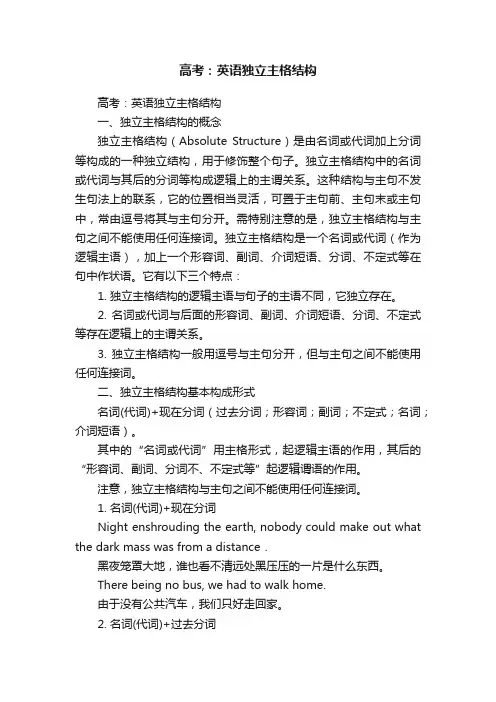
高考:英语独立主格结构高考:英语独立主格结构一、独立主格结构的概念独立主格结构(Absolute Structure)是由名词或代词加上分词等构成的一种独立结构,用于修饰整个句子。
独立主格结构中的名词或代词与其后的分词等构成逻辑上的主谓关系。
这种结构与主句不发生句法上的联系,它的位置相当灵活,可置于主句前、主句末或主句中,常由逗号将其与主句分开。
需特别注意的是,独立主格结构与主句之间不能使用任何连接词。
独立主格结构是一个名词或代词(作为逻辑主语),加上一个形容词、副词、介词短语、分词、不定式等在句中作状语。
它有以下三个特点:1. 独立主格结构的逻辑主语与句子的主语不同,它独立存在。
2. 名词或代词与后面的形容词、副词、介词短语、分词、不定式等存在逻辑上的主谓关系。
3. 独立主格结构一般用逗号与主句分开,但与主句之间不能使用任何连接词。
二、独立主格结构基本构成形式名词(代词)+现在分词(过去分词;形容词;副词;不定式;名词;介词短语)。
其中的“名词或代词”用主格形式,起逻辑主语的作用,其后的“形容词、副词、分词不、不定式等”起逻辑谓语的作用。
注意,独立主格结构与主句之间不能使用任何连接词。
1. 名词(代词)+现在分词Night enshrouding the earth, nobody could make out what the dark mass was from a distance.黑夜笼罩大地,谁也看不清远处黑压压的一片是什么东西。
There being no bus, we had to walk home.由于没有公共汽车,我们只好走回家。
2. 名词(代词)+过去分词The workers worked still harder, their living conditions greatly improved.由于工人们的生活条件大大提高,他们工作得更起劲了。
He was listening attentively in class, his eyes fixed on the blackboard.他上课专心听讲,眼睛紧盯着黑板。
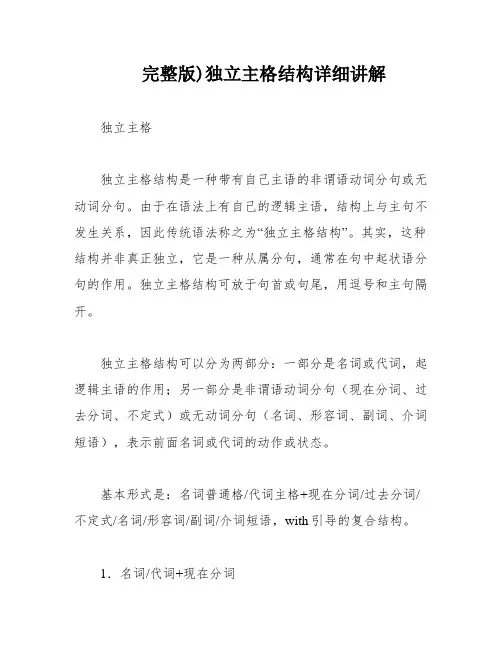
完整版)独立主格结构详细讲解独立主格独立主格结构是一种带有自己主语的非谓语动词分句或无动词分句。
由于在语法上有自己的逻辑主语,结构上与主句不发生关系,因此传统语法称之为“独立主格结构”。
其实,这种结构并非真正独立,它是一种从属分句,通常在句中起状语分句的作用。
独立主格结构可放于句首或句尾,用逗号和主句隔开。
独立主格结构可以分为两部分:一部分是名词或代词,起逻辑主语的作用;另一部分是非谓语动词分句(现在分词、过去分词、不定式)或无动词分句(名词、形容词、副词、介词短语),表示前面名词或代词的动作或状态。
基本形式是:名词普通格/代词主格+现在分词/过去分词/不定式/名词/形容词/副词/介词短语,with引导的复合结构。
1.名词/代词+现在分词现在分词表示前面的名词或代词主动进行的动作或状态等。
例如:The man lay there。
his hands trembling。
So many students being absent。
the meeting had to be put off。
His homework done。
Tom went to sleep。
有时,独立结构中的being或havingbeen可以省去,这样就成了无动词分句或过去分词分句。
2.名词/代词+过去分词过去分词表示前面的名词或代词被动完成的动作或所处的一种状态。
例如:The boy lay on his back。
his hands crossed under his head。
The job not finished。
we couldn’t see the film。
Her shirt caught on a nail。
she could not move。
如果加上havingbeen或being,这些句子就又变成了现在分词分句。
3.名词/代词+不定式不定式表示将来的动作。
例如:XXX going for a ic。
with Mary to provide the food.These are the first two books。
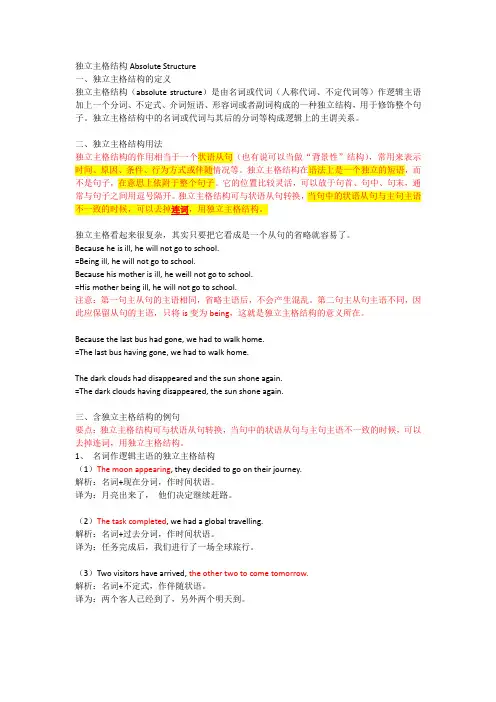
独立主格结构Absolute Structure一、独立主格结构的定义独立主格结构(absolute structure)是由名词或代词(人称代词、不定代词等)作逻辑主语加上一个分词、不定式、介词短语、形容词或者副词构成的一种独立结构,用于修饰整个句子。
独立主格结构中的名词或代词与其后的分词等构成逻辑上的主谓关系。
二、独立主格结构用法独立主格结构的作用相当于一个状语从句(也有说可以当做“背景性”结构),常用来表示时间、原因、条件、行为方式或伴随情况等。
独立主格结构在语法上是一个独立的短语,而不是句子,在意思上依附于整个句子。
它的位置比较灵活,可以放于句首、句中、句末,通常与句子之间用逗号隔开。
独立主格结构可与状语从句转换,当句中的状语从句与主句主语独立主格看起来很复杂,其实只要把它看成是一个从句的省略就容易了。
Because he is ill, he will not go to school.=Being ill, he will not go to school.Because his mother is ill, he weill not go to school.=His mother being ill, he will not go to school.注意:第一句主从句的主语相同,省略主语后,不会产生混乱。
第二句主从句主语不同,因此应保留从句的主语,只将is变为being,这就是独立主格结构的意义所在。
Because the last bus had gone, we had to walk home.=The last bus having gone, we had to walk home.The dark clouds had disappeared and the sun shone again.=The dark clouds having disappeared, the sun shone again.三、含独立主格结构的例句要点:独立主格结构可与状语从句转换,当句中的状语从句与主句主语不一致的时候,可以去掉连词,用独立主格结构。
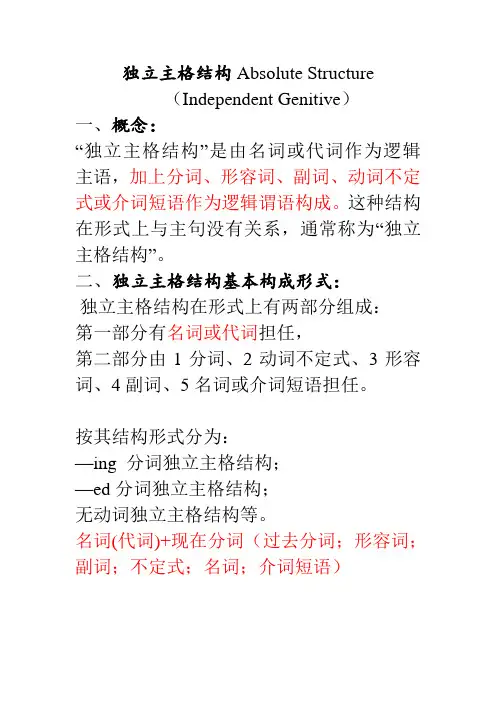
独立主格结构Absolute Structure(Independent Genitive)一、概念:“独立主格结构”是由名词或代词作为逻辑主语,加上分词、形容词、副词、动词不定式或介词短语作为逻辑谓语构成。
这种结构在形式上与主句没有关系,通常称为“独立主格结构”。
二、独立主格结构基本构成形式:独立主格结构在形式上有两部分组成:第一部分有名词或代词担任,第二部分由1分词、2动词不定式、3形容词、4副词、5名词或介词短语担任。
按其结构形式分为:—ing 分词独立主格结构;—ed分词独立主格结构;无动词独立主格结构等。
名词(代词)+现在分词(过去分词;形容词;副词;不定式;名词;介词短语)1. 名词(代词)+现在分词There being no bus, we had to walk home.由于没有公共汽车,我们只好走回家。
2.名词(代词)+过去分词He was listening attentively in class, his eyes fixed on the blackboard.他上课专心听讲,眼睛紧盯着黑板。
3. 名词(代词)+不定式在“名词/代词+动词不定式”结构中,动词不定式和它前面的名词或代词如果存在着逻辑上的主谓关系,动词不定式则用主动的形式;如果是动宾关系,则用被动形式。
He is leaving for the conference next week, all expenses to be paid by his company.他下周去参加一个会议,所有费用由他的公司支付。
We divided the money, he to have half of them .4. 名词(代词)+形容词Computers very small, we can use them widely.电脑虽小,我们却能广泛地利用它们。
5. 名词(代词)+副词The meeting over, our headmaster soon left the meeting room.散会了,校长很快就离开了会议室。
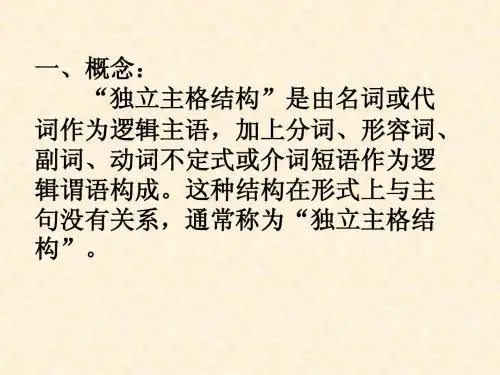
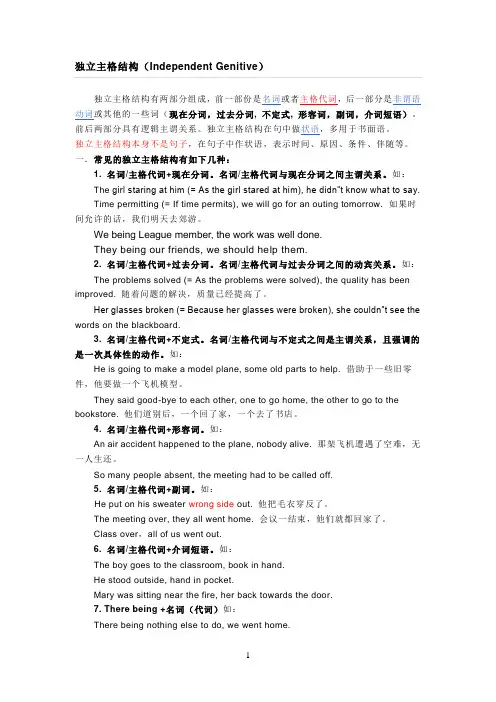
独立主格结构(Independent Genitive)独立主格结构有两部分组成,前一部份是名词或者主格代词,后一部分是非谓语动词或其他的一些词(现在分词,过去分词, 不定式, 形容词,副词,介词短语)。
前后两部分具有逻辑主谓关系。
独立主格结构在句中做状语,多用于书面语。
独立主格结构本身不是句子,在句子中作状语,表示时间、原因、条件、伴随等。
一.常见的独立主格结构有如下几种:1. 名词/主格代词+现在分词。
名词/主格代词与现在分词之间主谓关系。
如:The girl staring at him (= As the girl stared at him), he didn”t know what to say.Time permitting (= If time permits), we will go for an outing tomorrow. 如果时间允许的话,我们明天去郊游。
We being League member, the work was well done.They being our friends, we should help them.2. 名词/主格代词+过去分词。
名词/主格代词与过去分词之间的动宾关系。
如:The problems solved (= As the problems were solved), the quality has been improved. 随着问题的解决,质量已经提高了。
Her glasses broken (= Because her glasses were broken), she couldn”t see the words on the blackboard.3. 名词/主格代词+不定式。
名词/主格代词与不定式之间是主谓关系,且强调的是一次具体性的动作。
如:He is going to make a model plane, some old parts to help. 借助于一些旧零件,他要做一个飞机模型。
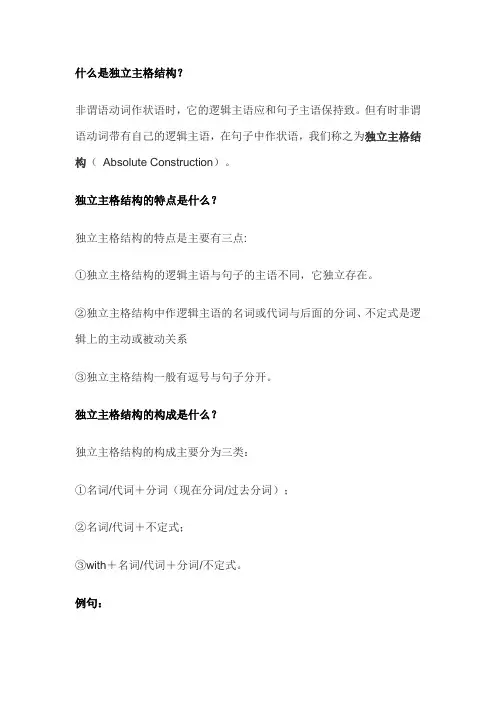
什么是独立主格结构?非谓语动词作状语时,它的逻辑主语应和句子主语保持致。
但有时非谓语动词带有自己的逻辑主语,在句子中作状语,我们称之为独立主格结构(Absolute Construction)。
独立主格结构的特点是什么?独立主格结构的特点是主要有三点:①独立主格结构的逻辑主语与句子的主语不同,它独立存在。
②独立主格结构中作逻辑主语的名词或代词与后面的分词、不定式是逻辑上的主动或被动关系③独立主格结构一般有逗号与句子分开。
独立主格结构的构成是什么?独立主格结构的构成主要分为三类:①名词/代词+分词(现在分词/过去分词);②名词/代词+不定式;③with+名词/代词+分词/不定式。
例句:①The test finished(=When the test was finished),we began our holiday.考试结束了,我们开始放假。
②The president assassinated(=Because the president was assassinated),the whole country was in deep sorrow.总统被暗杀了,全国上下沉浸在悲痛之中。
.[əˈsæsəˌneɪt]③Weather permitting(=If weather permits),we are going to visit you tomorrow.如果天气允许,我们明天打算去看你。
④I stood before her with my heart beating fast.我站在她面前,心脏跳得很快。
练习题:①The party will be held in the garden,weatherA. permittingB. to permitC. permittedD. permit②The children went home from the grammar school,theirlessons___for the day.A.finishingB.finishedC.had finishedD. went finished③The old couple often take a walk after supper in the park with their pet dog____ them.A. to followB. followingC. followedD.follows④I couldn't do my homework with all that noise_____A. going onB. goes onC. went onD. to go⑤The lecture(讲座)____, a lively question--and--answer session followed(跟随; 接着). 尤指法庭、议会等)开庭, 开会A. being givenB. having givenC. to be givenD. having been given答案:A B B A D。
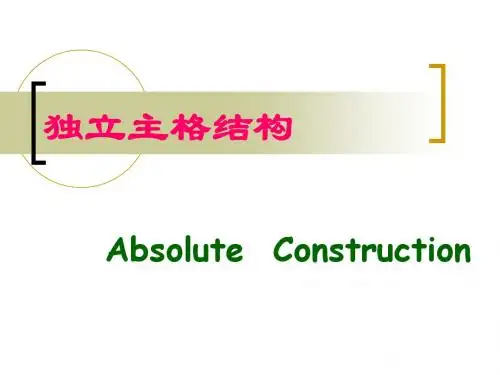
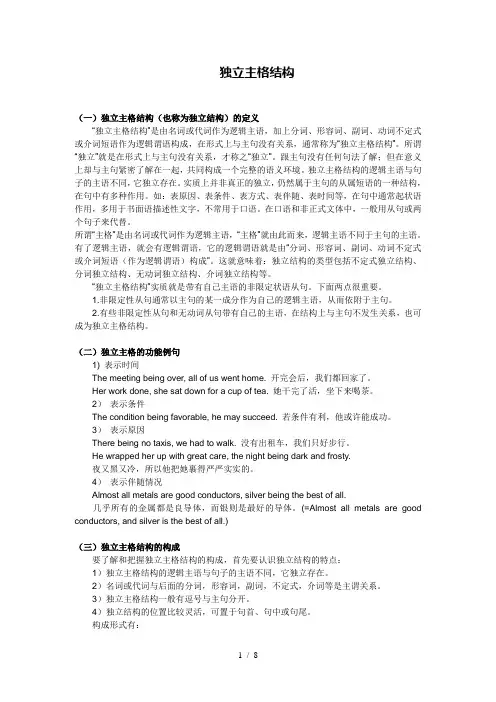
独立主格结构(一)独立主格结构(也称为独立结构)的定义“独立主格结构”是由名词或代词作为逻辑主语,加上分词、形容词、副词、动词不定式或介词短语作为逻辑谓语构成,在形式上与主句没有关系,通常称为“独立主格结构”。
所谓“独立”就是在形式上与主句没有关系,才称之“独立”。
跟主句没有任何句法了解;但在意义上却与主句紧密了解在一起,共同构成一个完整的语义环境。
独立主格结构的逻辑主语与句子的主语不同,它独立存在。
实质上并非真正的独立,仍然属于主句的从属短语的一种结构,在句中有多种作用。
如:表原因、表条件、表方式、表伴随、表时间等,在句中通常起状语作用,多用于书面语描述性文字,不常用于口语。
在口语和非正式文体中,一般用从句或两个句子来代替。
所谓“主格”是由名词或代词作为逻辑主语,“主格”就由此而来,逻辑主语不同于主句的主语。
有了逻辑主语,就会有逻辑谓语,它的逻辑谓语就是由“分词、形容词、副词、动词不定式或介词短语(作为逻辑谓语)构成”。
这就意味着:独立结构的类型包括不定式独立结构、分词独立结构、无动词独立结构、介词独立结构等。
“独立主格结构”实质就是带有自己主语的非限定状语从句。
下面两点很重要。
1.非限定性从句通常以主句的某一成分作为自己的逻辑主语,从而依附于主句。
2.有些非限定性从句和无动词从句带有自己的主语,在结构上与主句不发生关系,也可成为独立主格结构。
(二)独立主格的功能例句1) 表示时间The meeting being over, all of us went home. 开完会后,我们都回家了。
Her work done, she sat down for a cup of tea. 她干完了活,坐下来喝茶。
2)表示条件The condition being favorable, he may succeed. 若条件有利,他或许能成功。
3)表示原因There being no taxis, we had to walk. 没有出租车,我们只好步行。
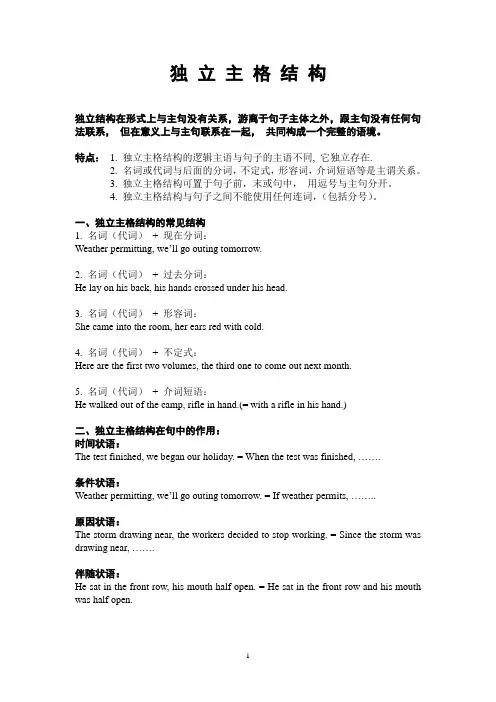
独立主格结构独立结构在形式上与主句没有关系,游离于句子主体之外,跟主句没有任何句法联系,但在意义上与主句联系在一起,共同构成一个完整的语境。
特点: 1. 独立主格结构的逻辑主语与句子的主语不同, 它独立存在.2. 名词或代词与后面的分词,不定式,形容词,介词短语等是主谓关系。
3. 独立主格结构可置于句子前,末或句中,用逗号与主句分开。
4. 独立主格结构与句子之间不能使用任何连词,(包括分号)。
一、独立主格结构的常见结构1. 名词(代词)+ 现在分词:Weather permitting, we’ll go outing tomorrow.2. 名词(代词)+ 过去分词:He lay on his back, his hands crossed under his head.3. 名词(代词)+ 形容词:She came into the room, her ears red with cold.4. 名词(代词)+ 不定式:Here are the first two volumes, the third one to come out next month.5. 名词(代词)+ 介词短语:He walked out of the camp, rifle in hand.(= with a rifle in his hand.)二、独立主格结构在句中的作用:时间状语:The test finished, we began our holiday. = When the test was finished, …….条件状语:Weather permitting, we’ll go outing tomorrow. = If weather permits, ……..原因状语:The storm drawing near, the workers decided to stop working. = Since the storm was drawing near, …….伴随状语:He sat in the front row, his mouth half open. = He sat in the front row and his mouth was half open.三、WITH结构1. with+ 宾语+ 现在分词(表示正在发生或发生了的动作)With the boy leading the way, we found his home easily.2. with+ 宾语+ 过去分词(表示被动或完成)He stood silently, with his eyes fixed on the screen.3. with+ 宾语+ 不定式(表示将要发生的动作)With so much homework to do, I can’t go to the party tonight.4. with+ 宾语+ 介词短语With his wife out of temper, he decided to stay at home.5.with+ 宾语+ 形容词She came into the room, her ears red with cold.典型例题:1. The teacher came into the classroom, _________.A. a book in handB. book in his handC. book in handD. a book in his hand2. The sale usually takes place outside the house, with the audience ________ on the benches, chairs or boxes.A. having seatedB. seatingC. seatedD. having been seated3. Without the sun’s light _______ the earth’s surface, it would be so cold that life could not exist on earth.A. warmsB. warmedC. warmingD. to warm4.________, a man who expresses himself effectively is sure to succeed more rapidly than a man whose command of language is poor.A. Other things being equalB. Were other things equalC. To be equal to other thingsD. Other things to be equal5.All flights ________ because of the snowstorm, many passengers could do nothing but take the train.A. had been canceledB. have been canceledC. were canceledD. having been canceled6.All the tasks _______ ahead of time, they decided to go on holiday for a week. been fulfilled B. having been fulfilled C. were fulfilledD. had been fulfilled.7.A new technique _______, the production increased by 20 percent.A. to have been worked outB. having worked outC. working outD. having been worked out8._______, everything has changed.A. Time goes onB. Time going onC. As time going onD. With time went on四、独立主格结构与独立成分的异同:1. 有的分词短语可以独立存在,在句子中没有逻辑上的主语,实际已成为习惯短语。

独立主格8种结构一、独立主格结构是指在句子中,独立地出现的名词性短语,它不与主句的其他成分构成任何关系,一般用逗号隔开。
1. 时间状语独立主格结构例如:走到窗前,小明看到了美丽的夕阳。
在这个例句中,“走到窗前”是时间状语独立主格结构,它表示的是动作的时间。
2. 原因状语独立主格结构例如:天气太热了,大家都不愿意出去玩。
在这个例句中,“天气太热了”是原因状语独立主格结构,它表示的是动作的原因。
3. 条件状语独立主格结构例如:天气好的话,我们就去游泳吧。
在这个例句中,“天气好的话”是条件状语独立主格结构,它表示的是动作的条件。
4. 目的状语独立主格结构例如:为了赚钱,他每天都加班到很晚。
在这个例句中,“为了赚钱”是目的状语独立主格结构,它表示的是动作的目的。
5. 结果状语独立主格结构例如:他学习非常努力,成绩自然会提高。
在这个例句中,“他学习非常努力”是结果状语独立主格结构,它表示的是动作的结果。
6. 让步状语独立主格结构例如:尽管天气很冷,他还是坚持锻炼。
在这个例句中,“尽管天气很冷”是让步状语独立主格结构,它表示的是动作的让步条件。
7. 方式状语独立主格结构例如:他边听音乐,边做作业。
在这个例句中,“边听音乐”是方式状语独立主格结构,它表示的是动作的方式。
8. 伴随状语独立主格结构例如:他一边吃饭,一边看电视。
在这个例句中,“一边吃饭”是伴随状语独立主格结构,它表示的是动作的伴随状态。
通过以上的例子,我们可以看出独立主格结构的灵活运用能够使得句子更加丰富多样,表达更加准确清晰。
熟练掌握这些结构,能够让我们的写作更加生动有趣,同时也能提高我们的语言表达能力。
所以,在写作中,我们应该多加运用独立主格结构,让我们的句子更加地道、准确。
独立主格结构独立主格结构是一种特殊的结构,用于修饰整个句子,与主句之间不能使用任何连接词,其具有两个特点:1. 独立主格结构的逻辑主语与句子的主语不同,它独立存在。
2. 独立主格结构一般用逗号与句子分开。
◆独立主格结构有三种类型:◆逻辑主语+非谓语动词(不定式、现在分词、过去分词)◆逻辑主语+(being)+表语(名词、形容词、副词、介词短语)◆with/without +复合宾语(不定式、现在/过去分词、形容词、副词、介词短语)1. “名词/代词+不定式”结构,往往表示不定式通常表示尚未发生或即将要发生的动作。
e.g. His friends to come tonight, he is busy preparing the dinnere.g. No one to wake me up, I might be late for the first class.如果没人叫醒我,我会错过第一节课的。
2. “名词/代词+现在分词”结构现在分词常作时间状语、原因状语、条件状语、方式或伴随状语等,通常表示动作正在进行(或当时正在进行)。
有时表示一般情况的状态或动作。
Their room was on the third floor, it`s window overlooking the sports groundEveryone having sat down, the teacher began his class.(相当于时间状语从句: When everyone had sat down)The boy leading the way, we had no trouble getting out of the forest. (相当于:Because the boy led the way)My health allowing, I will work far into the night.(相当于:If my health allows)We redoubled our efforts, each man working like two.The students are walking in the school happily, each wearing a card infront of his chest.3. “名词/代词+过去分词”结构:过去分词通常表示被动意义或完成意义。
独立主格结构独立主格结构(Independent Genitive)由两部分组成,前一部份是名词或者代词,后一部分是非谓语动词(不定式、动名词和分词)或形容词、副词、名词或介词短语。
前后两部分具有逻辑主谓关系。
独立主格结构在句中做状语,多用于书面语。
独立主格结构本身不是句子,在句子中作状语,表示时间、原因、条件、伴随、目的等。
独立主格,首先它是一个“格”,而不是一个“句子”,在英语中任何一个句子都要有主谓结构,而在这个结构中,没有真正的主语和谓语动词,但又在逻辑上构成主谓或主表关系。
结构:n/pron + 非谓语V一、一般独立主格形式,与主句逻辑关系松散1、n/ pron + V-ing 表示主动关系The girl staring at him , he didn’t know what to say .Time permitting , we will go for an outing tomorrow.2、n/ pron + V-ed 表示被动关系The problems solved , the quality has been improved.3、n/ pron + to do 表示主动关系,强调的是一次具体性的动作He is going to make a model plane , some old parts to help.4、n/ pron + adj / adv / n / 介词短语An air accident happened to the plane ,nobody alive.He put on his sweater ,wrong side out .The boy goes to the classroom , book in hand .Two hundred people died in the accident ,many of them children .His first shot failure, he fired again .二、with 引导的独立主格,与逻辑主语关系紧密(多数情况下with可以省略,但without 不可以省略)结构:With(without) +宾语(n/ pron) + 宾语补足语(V-ed / V-ing / adj / 介词短语)Without a word more spoken , she left the meeting room .三、each引导的强调型独立主格句子+ n(复数结尾),each + 介词短语/ 形容词短语/ 名词短语/ V-ing / V-ed形式,这种结构为了强调句尾的名词(复数)Under the restructuring, the huge organization that operates the company's basic businesses will be divided into five groups, each with its own executive。
独立主格结构基本概念1.独立结构的实质和类型所谓“独立结构”(Absolute Construction)实质就是带有自己主语的非限定分句和无动词分句。
如前所述,非限定分句和无动词分句通常是以主语的一定成分作为自己的逻辑主语,从而依附于主语。
但也有一些非限定分句和无动词分句带有自己的主语,从而在结构上与主语不发生关系,因此叫“独立结构”。
其实,所谓“独立结构”也并非真正独立,它还是一种从属分词。
“独立结构”按其结构形式,分为不定式“独立结构”,-ing分词“独立结构”,-ed分词“独立结构”和无动词“独立结构”,通常在句中起状语分句的作用。
例如:(1)A number of officials followed the emperor, some to hold his robe, others to adjust his girdle, and so on.许多官员尾随皇帝之后,有的拎着皇帝的衣袍,有的则给他整腰带等。
(some to hold…和others to adjust…为不定式独立结构)(2)There being nothing else to do, we left.由于没有其它事情可做,我们离开了。
(There being…为-ing分词独立结构)(3)She gazed, her hands clasped to her breast.她凝视着,双手叉在胸前。
(her hands clasped…为-ed分词独立结构)(4)He went off, gun in hand.他手里拿着枪离开了。
(gun in hand为无动词独立结构)(5)The floor wet and slippery, we stayed outside.由于地板又湿又滑,我们呆在屋外。
(The floor wet…为无动词“独立结构”)2.“独立结构”的用法和意义由上述诸例可以看出,“独立结构”与主语之间通常用逗号隔开,但也有用破折号的。
例如:(6)The room was in chaos--- dirty clothes strewn on the floor, cosmetics scattered over the dresser, empty bottles and cans everywhere.房间一片混乱,脏衣服扔在地板上,化装品散乱在梳妆台上,到处都是空的瓶。
在“独立结构”中做主语的名词词组有时可以省去限定词。
例如:(7)The manager sat quietly in the office, (his ) eyes closed.经理静静地坐在办公室里,双目紧闭。
“独立结构”的位置是比较灵活的,它可位于句首,句中或句尾。
例如:(8)Their room was on the third floor, its window overlooking the sports ground. 他们的房间在三层楼上,窗户俯视着操场。
(9)He guiding her, they stumbled through the street.他引着他,两个人蹒跚地穿过那条街。
(10)He, God willing, would be in the village before the second next month.他,如果情况允许,将于下月二日前来到这个村庄。
如果一句中含有几个“独立结构”,通常是把表示概括意义的结构置于最后。
例如:(11)The professor was slammed against the wall, his body frisked, his wrists handcuffed, his dignity lost.教授被猛推倒墙上,被搜了身,手被拷着,尊严尽失。
“独立结构”在句中可表示多种含义。
例如:表示时间:(12)His homework done, Jim decided to go and see the play.=After his homework was done, Jim decided to go and see the play.家庭作业完成之后,杰姆决定去看戏。
(13)The meal over, we began to work again.=When the meal was over, we began to work again. 吃完饭,我们又开始干活。
表示原因:(14)The last bus giving gone, we had to walk home.=Because the last bus had gone, we had to walk home.由于末班车已开走,我们只得步行回家。
(15)Her shirt caught on a nail, she could not move.=As her shirt was caught on a nail, she could not move. 由于裙子被钉子钩住,她不能移动。
表示条件:(16)Whether permitting, the football match will be played on Wednesday.=If weather permits, the football match will be played on Wednesday. 假如天气允许的话,足球赛将在星期三举行。
表示方式和伴随状况:(17)He put on his socks wrong side out.他穿上袜子,反面朝上。
(18)The children were watching the acrobatic show, their eye (being) wide open.孩子们在看杂技表演,眼睛睁得很大。
在上述诸例中,“独立结构”均可变为由with引导的介词词组,即在“独立结构”前可用介词with。
介词with在此没有什么意义,只是比较口语化。
例如:(19)They sat in the room with the curtains drawn.他们坐在房间里,窗帘拉下来。
With the tree growing tall, we get more shade.树长高了,我们得到更多的阴凉。
He came into the classroom with a book in his hand.他手里拿着一本书走进教室。
重点疑难1.不定式“独立结构”,-ing分词“独立结构”,-ed分词“独立结构”之间的区别。
不定式“独立结构”表示即将发生的动作。
例如:(1);We shall assemble at ten forty-five, the procession to start moving at precisely eleven.我们将在十点四十五分集合,队伍整十一点开始游行。
(2);The plan was that the two parties should first reach an agreement on the basic principle, the details to be worked put later.计划是双方应先就基本原则达成协议,细节问题以后拟订。
-ing分词“独立结构”表示正在进行的动作,且主语与-ing分词之间为主动关系。
例如:(3);We redoubled our efforts, each man working like two.我们加倍努力,每一个人就像干两个人的活。
-ed分词“独立结构”表示已发生的动作,主语与-ed分词之间为被动关系。
例如:(4);This done, we went home.做完此事,我们就回去。
(5);All our saving gone, we started looking for jobs.积蓄全部用完了,我们就开始找工作。
2.无动词“独立结构”的常见类型:(1);名词+介词短语(2);名词+adj.或adv.例如:He sat st the table, collar off, head down, and pen in position, ready to begin the long letter.专项练习将下列每组句子连接成一句,至少使用一个独立结构。
1.a.She stood back and looked at him.b.Her face smiled radiantly.2.a.His exam was finished.b.Porter stumbled wearily from the room.3.a.Henry Adams ran from the room .b.Cold shivers ran down his spine.4.a.The meeting was closed.b.Nobody had any more to say.5.a.There was no way for me to cross.b.I walked upstream on the south side.6.a.Marie sat on the edge of frail wooden chair in Irby\'s suite.b.The champagne glass was in her hand.c.Her tears were in her eyes.7.a.All the money had been spent.b. Jack started looking for work.8.a.The whole meeting was in uproar.b.The chairman abandoned the attempt to take a vote.9.a.My task was completed.b.I went to bed.10.a. In front of him stood a man.b.The man held a gun in his hand.11.a. Walking into the room, I saw Grandpa.b.He was sitting at the desk.c.His newspaper was spread before him.12. a. The prisoner stood quietly on the wooden platform.b.A small cotton bag was put over his face.c.His hands were tied behind his back.d.A noose was fixed securely about his neck.。